Standard [CURRENT]
ASTM E 273:2025
Standard Practice for Ultrasonic Testing of the Weld Zone of Welded Pipe and Tubing
- Publication date
- 2025
- Original language
- English
- Pages
- 5
- Publication date
- 2025
- Original language
- English
- Pages
- 5
- DOI
- https://dx.doi.org/10.1520/E0273-25
Product information on this site:
Quick delivery via download or delivery service
Buy securely with a credit card or pay upon receipt of invoice
All transactions are encrypted
Short description
1.1 This practice 2 covers general ultrasonic testing procedures for the detection of discontinuities in the weld and adjacent heat affected zones of welded pipe and tubing by scanning with relative motion between the search unit and pipe or tube. When contact or unfocused immersion search units are employed, this practice is intended for tubular products having specified outside diameters ≥ 2 in. ( ≥ 50 mm) and specified wall thicknesses of 1/8 in. to 11/16 in. (3 mm to 27 mm). When properly focused immersion search units are employed, this practice may also be applied to material of smaller diameter and thinner wall. When contact or immersion phased array search units are employed, this practice may also be applied to material of above-mentioned outside diameters and wall thicknesses. Note 1: When contact or unfocused immersion search units are used, precautions should be exercised when examining pipes or tubes near the lower specified limits. Certain combinations of search unit size, frequency, thin-wall thicknesses, and small diameters could cause generation of unwanted sound waves that may produce erroneous examination results. 1.2 All surfaces of material to be examined in accordance with this practice shall be clean from scale, dirt, burrs, slag, spatter, or other conditions that would interfere with the examination results. The configuration of the weld must be such that interfering signals are not generated by reflections from it. Treatment of the inner surface and outer surface weld beads such as trimming ("scarfing") or rolling is often required to remove protuberances that could result in spurious reflections. 1.3 This practice does not establish acceptance criteria; they must be specified by the using parties. 1.4 Units- The values stated in inch-pound units are to be regarded as standard. The values given in parentheses are mathematical conversions to SI units that are provided for information only and are not considered standard. 1.5 This standard does not purport to address all of the safety concerns, if any, associated with its use. It is the responsibility of the user of this standard to establish appropriate safety, health, and environmental practices and determine the applicability of regulatory limitations prior to use. 1.6 This international standard was developed in accordance with internationally recognized principles on standardization established in the Decision on Principles for the Development of International Standards, Guides and Recommendations issued by the World Trade Organization Technical Barriers to Trade (TBT) Committee.
ICS
23.040.01
DOI
https://dx.doi.org/10.1520/E0273-25
Also available in
Loading recommended items...
Loading recommended items...
Loading recommended items...

